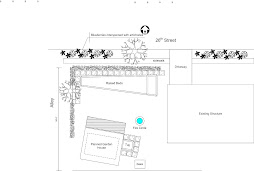Most of all I've enjoyed the opportunity to do so much of this with Kristin. She's an odd one, my kind of girl, the type that gets excited about a pickup load of manure, the whorl pattern of an echinacea flower head, or saving seeds. I hope we enjoy many future seasons of gardening and canning and that we have the opportunity to create many more gardens together.
Many neighbors and friends have been super. Some mostly remind me that there's stuff that needs eating. That's fine! Others pick up shovels and rakes and whatnot and dig in. Stormi has been a great friend to the garden in that regard. Lynda (aka "Queen Basilica") got some good digs in too.
I'm also fortunate to know a couple of what I'd call 'hard hitters' in the making-gardens-happen world. My young friend Andy has energy and muscles and a work ethic that I can only vaguely remember. He's awesome! Andy moved probably as much earth and rock as I did this year. Go, Andy! I hope you have a lifetime of pleasure growing things! Loren (also endowed with admirable git-r-done qualities) put a lot of path in with me and did a ton of work on the concrete beds. I am always amazed at how much he can accomplish in a short time. Loren has a great knack for making beautiful things from whatever's at hand.
In May, a whole tribe of workshop participants converged and really got the growing side moving with a weekend of planting. I was away at the time in a very hot and dismal part of the world, so returning to their verdant handiwork in mid-June was almost miraculous. I have not even met most of them in person, but I owe them many thanks.
Now, I also and perhaps most importantly need to thank my bees, snakes, ladybugs, nematodes, wasps, birds, various mystery soil denizens, unbelievably indolent house cats, plants, sun, rain, and wind for doing all the hard work. This last shout-out may strike some people as frivolous, but a single honeybee, you should know, produces only about one-eighth of a teaspoon of honey in its entire lifetime. I am certain, on that account, that I will never show as much dedication myself to such a beautiful enterprise, and so I am grateful for theirs.
Happy Fall!

